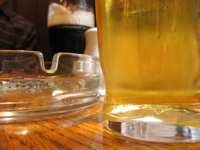|
||
      |
Citations
Mentally healthy religion
African Americans with a strong belief in God suffer less depression than nonbelievers, found a team led by John Cacioppo, the Tiffany & Margaret Blake distinguished service professor of psychology. A preliminary analysis of data from the ongoing Chicago Health, Aging, and Social Relations Study showed that blacks with religious convictions had fewer depressive symptoms. Among white participants in the study, faith did not affect mental health. The researchers theorized that African Americans, who reported higher levels of alienation than whites, use spirituality to help surmount such feelings.

Cigarettes and alcohol go hand-in-hand.
A drink and a drag
Like gin and tonic, smoking and drinking often go together. There may be a scientific explanation for the latter pairing: smokers have stronger cigarette cravings when they drink, associate professor of psychiatry Andrea King and the Illinois Institute of Technology’s Alyssa Epstein report in the April Alcoholism: Clinical & Experimental Research. In a study of 16 social drinker-smokers, the psychologists found that the more participants tossed back, the more they wanted a drag. While a non-alcoholic placebo had no effect, the nicotine urge increased after downing four versus two drinks.
Freakademics
Steven Levitt, the Alvin H. Baum professor of economics, has gone where no economist has gone before—several times over. In his new book, Freakonomics: A Rogue Economist Explores the Hidden Side of Everything (HarperCollins), Levitt presents his previously published research for a general audience. Unleashing his financial theories on the real world, he reveals patterns previously overlooked. Scrutinizing standardized-test answer sheets, for example, he shows that Chicago Public Schools teachers inflated their students’ scores. With journalist Stephen Dubner as his coauthor, Levitt ventures into other unlikely territories including sumo wrestling, drug dealing, and parenting.
Of dinosaurs and droplets
Asix-mile-wide asteroid did more than wipe out the dinosaurs when it smacked into Earth 65 million years ago. It also left a globe-encircling residue, consisting of hot-liquid droplets called spherules. Geologists have long puzzled over the residue’s origin, theorizing that atmospheric friction melted the sand-sized droplets off the asteroid or that they splashed out of the impact crater in Mexico’s Yucatan Peninsula. Using computer simulations Lawrence Grossman, professor in geophysical sciences, and the American Museum of Natural History’s Denton Ebel have solved the mystery. The duo report in the April Geology that the spherules condensed from a fireball, formed in the impact’s wake, as it cooled from temperatures that reached tens of thousands of degrees.
What’s the matter
Building on earlier work that forged a new form of matter, a Bose-Einstein condensate, physicists including assistant professor Cheng Chin have merged the simple molecules into larger clusters at temperatures near absolute zero. The feat, accomplished using the Feshbach resonance technique, could lead to advances in quantum computing in which ultracold gas atoms serve as bits for storing information. Slated for an upcoming Physical Review Letters, the research also could improve the understanding of superconductivity and superchemistry, an emerging field that draws on physics and chemistry.